The WaterSense Current Winter 2009
In This Issue IX, Winter 2009:
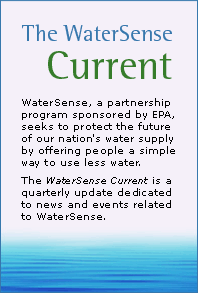 |
In This Issue: |
Fix a Leak, Save Some Green
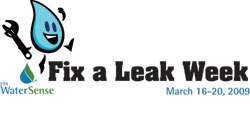
How long have you been ignoring that pitter patter coming from the shower? How about the leaky spigot on the side of the house, or that running toilet? You might as well be pouring money down the drain! Fixing easily corrected household water leaks like these can save homeowners more than 10 percent on their water bills—and a precious natural resource.
March 16 to 20, 2009, marks the WaterSense program's first "Fix a Leak Week," a time to remind Americans to attack leaks in their household fixtures and irrigation systems. While leaks might sometimes seem like small problems, over time they waste both valuable water resources and money. On average, a U.S. household wastes more than 11,000 gallons of water per year—enough to fill a backyard swimming pool!
Common types of leaks found in the home are leaking toilet flappers, dripping faucets, and other leaking valves. These types of leaks are easily correctable, in many cases requiring only a few tools and hardware, such as a wrench and drops of food coloring, which will easily pay for themselves in water savings. If you discover a significant leak that merits the replacement of an older toilet or bathroom sink faucet, consider a new WaterSense labeled product that will not only put an end to your leak, but also increase water efficiency. For instance, WaterSense labeled faucets use 30 percent less water without a noticeable difference in flow.
While some leaks are obvious, others are more difficult to detect. To be sure that your household is leak-free, check your water meter before and after a two-hour period when no water is being used. If the meter does not read exactly the same, you probably have a leak—and an opportunity to save water and some extra cash.
Learn more tips and information about Fix a Leak Week.
Add a Splash of WaterSense:
Download the Widget
Bring a splash of water savings know-how to your Web site with the WaterSense widget!
The WaterSense widget is an application that displays water-efficiency content directly on your Web page and provides a link to the WaterSense Web site.
Once you have added the widget to your Web page, there is no technical maintenance. WaterSense will update the content automatically, displaying a new tip on water efficiency regularly. There are three variations of the widget that are available for use, such as the one pictured at right.
Raising the Roof on Water Efficiency:
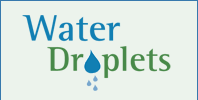
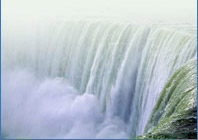
New Homes Pilot Makes Headway
The first home built to the WaterSense draft specification for new homes has opened its doors. Compared with a traditional new home, it's expected to conserve 10,000 gallons of water per year, or be at least 20 percent more water efficient.
The 2,532-square-foot concept home in Chapel Hill, North
Carolina, is the handiwork of Vanguard
Homes![]() ,
one of seven builders participating in the WaterSense
New Homes pilot program. The pilot began in August 2008,
and, once completed in 2009, it will inform EPA's process
for home inspection and certification. (The Vanguard home
has been certified to the draft
specification.)
,
one of seven builders participating in the WaterSense
New Homes pilot program. The pilot began in August 2008,
and, once completed in 2009, it will inform EPA's process
for home inspection and certification. (The Vanguard home
has been certified to the draft
specification.)
"Through the WaterSense New Homes pilot program, we can lay a strong foundation for environmental progress," said former EPA Administrator Stephen L. Johnson at a ribbon-cutting ceremony at the concept home in November. "As the program encourages installation of products that save water and money, homeowners are realizing first-hand the benefits of efficient water use."
Besides WaterSense labeled toilets and bathroom sink faucets, the new house includes high-efficiency showerheads and ENERGY STAR qualified appliances. It is plumbed with insulated hot water lines to prevent hot water from cooling in the pipes, a recirculating hot water system to cut down on time needed for tap water to warm, and water-efficient landscaping.
Partner Profile: Kohler Co.
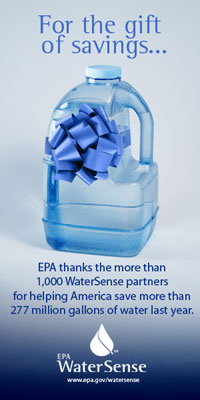
The WaterSense Current periodically profiles outstanding WaterSense partners and their achievements in advancing water efficiency and water-efficient products and practices.
Kohler Co. has been supporting WaterSense since before the program had a name, so perhaps it's no surprise the forward-thinking kitchen and bath manufacturer was named one of the program's first WaterSense Partners of the Year in 2008.
"We're very proud to have won this award and want as many
people to know as possible," says Rob Zimmerman, senior staff
engineer of Kohler water conservation initiatives. To wit: the day
EPA announced the award winners last October, Kohler spread the
announcement on one of the JumboTrons in Times Square, New York
City. And why not shout the news from the rooftop? From helping
sponsor the Grand
Canyon Adventure: River at Risk![]() IMAX film to sponsoring posh, portable water-efficient restrooms
in Times Square, the company has been awash in water efficiency.
IMAX film to sponsoring posh, portable water-efficient restrooms
in Times Square, the company has been awash in water efficiency.
"We as citizens need to do more to eliminate the waste of water," says Zimmerman. Plumbing products are a logical place to do that, especially "when you can do it without a sacrifice in user experience or product performance," he explains.
Kohler has been making efficient plumbing fixtures since the late 1980s with the introduction of the first generation of low-flow toilets. Technology has advanced considerably since those days, and Kohler now has four types of high-efficiency flushing mechanisms that meet EPA's WaterSense criteria: regular gravity-flush toilets, as well as dual-flush, pressure-assisted, and power-assisted types.
Zimmerman credits the WaterSense program for helping to bring focus and order to the evolution of water-efficient plumbing fixtures. "It gave us a target to hit in our new product development process," he says.
WaterSense has also helped Kohler to "cast a wider net," adds Zimmerman, enabling the company to broadcast the water-efficiency story to a wider audience, whether on the trade show circuit by embroidering company shirts with the WaterSense Partner of the Year logo or with the help of the company's spokesperson Ed Del Grande, better known as Ed the Plumber on the DIY Network.
What's next for Kohler in the water-efficiency arena? Zimmerman will only hint, "We have big plans for 2009."
Learn more about Kohler![]() .
.
Making Savings a Fixture
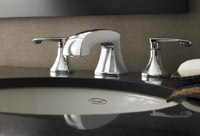
At least one company is making water efficiency the standard—none
other than American
Standard![]() . American Standard has earned the WaterSense label for not just a
few models, but its entire line of bathroom sink faucets.
. American Standard has earned the WaterSense label for not just a
few models, but its entire line of bathroom sink faucets.
Jeannette Long, director of marketing communications at American Standard, explains that the company is trying to make consumers' lives easier: "We like to simplify the [faucet] selection process for end users. The WaterSense label provides the end user assurance that any American Standard faucet meets water-efficiency requirements and performs well."
Products in the Pipeline: Showerheads
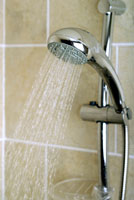
Since the WaterSense Current last covered plans for a showerhead specification in fall 2007, EPA has been working to develop criteria for highly effective, high-efficiency showerheads.
Creating a draft showerhead specification is no easy task. To earn the WaterSense label, a product must not only save water, but also perform as well as or better than conventional products on the market, and showerheads will be no exception. Unlike toilets and faucets, however, there are currently no universally agreed upon testing protocols for showerhead performance or definition for "user satisfaction." In other words, how do you define a good shower? That's the tricky part.
Since the characteristics of a water-efficient, high-performance showerhead are largely undefined, WaterSense has been collaborating with industry and water-efficiency experts through the American Society of Mechanical Engineers Joint Harmonization Task Force to create a definition. This work includes developing performance protocols that are reproducible and repeatable and can be tested in an independent laboratory, then correlating these performance protocols to actual consumer satisfaction. WaterSense is also carefully considering any health and safety issues.
Once the specification is finalized, showerheads will round out the suite of WaterSense labeled residential bathroom plumbing fixtures. It's been a long road, but the time, effort, and research involved with the development of this specification enforces the fact that WaterSense is dedicated to ensuring that any fixture that bears the label will help save water and still have people singing in the shower.




